Below is a deep-dive article for beginners on basic yoga tips and safe practices. We’ll talk about eight simple poses, explain how to do them step by step, and share what good things they do for you. This guide is long and friendly, with lots of images you can click on and links to more info from our pages.
Key Takeawaysof 8 Basic Yoga Poses for Beginners:
- Eight easy poses are explained in a step-by-step guide.
- Each pose comes with simple steps and benefits.
- Tips to practice safely and at your own pace.
- Clickable images and extra links to learn more.
Introduction
Yoga is a gentle way to help your body and mind feel calm and strong. If you’re new to yoga, it can seem a bit confusing, but don’t worry – we’ll show you how to do each pose with clear, simple steps. In this guide, we share some tips to help you start safely and enjoy the practice without fuss.
Every paragraph has an image you can click on to see more, so you can always check the steps visually. For more details on different types of yoga, you can always visit our page on Discover the different types of yoga. Let’s get into it!
1. Mountain Pose

Mountain Pose is one of the easiest and best ways to start your yoga practice. It might look like just standing still, but it is a good way to check your posture and calm your mind.
How to do it:
- Stand Up Tall: Stand with your feet a bit close together. You don’t need to force them together, just make sure they are stable on the ground.
- Relax Your Body: Let your arms hang naturally by your side. Keep your fingers relaxed and loose.
- Breathe Deep: Take a deep breath in slowly, and let it out. Try to keep your breathing steady and calm.
- Look Straight Ahead: Gaze ahead softly, and notice how your feet feel on the ground.
Benefits:
- Improved Posture: When you stand like a mountain, you make sure your back is straight and your shoulders are down. This can help you feel less tired during the day.
- Better Balance: Even when you’re standing still, balancing your weight can make your legs stronger.
- Calm Mind: Focusing on your breath and your stance can help clear your thoughts, so you feel less stressed.
Mountain Pose might seem very simple, but it is the foundation for many other yoga poses. It helps you learn how to stand correctly and be aware of your body. Even if you make a little mistake or feel wobbly at first, remember that practice makes perfect. Over time, your balance and posture will improve. For more on posture and balance tips, check out our page on 12 Powerful Yoga Poses for Flexibility.
Extra Tips:
- Take Your Time: Don’t rush. Stand in Mountain Pose for a minute or two to really feel the ground beneath you.
- Mind the Alignment: Make sure your head is balanced on top of your neck and your spine is long.
- Feel the Connection: Imagine your feet are rooted to the ground, like a tree, giving you stability and strength.
This pose is a simple way to remind yourself that every journey starts with a single, steady step. Even if it feels a bit silly at first, it’s a key part of feeling good and steady as you move into more active poses.
2. Tree Pose
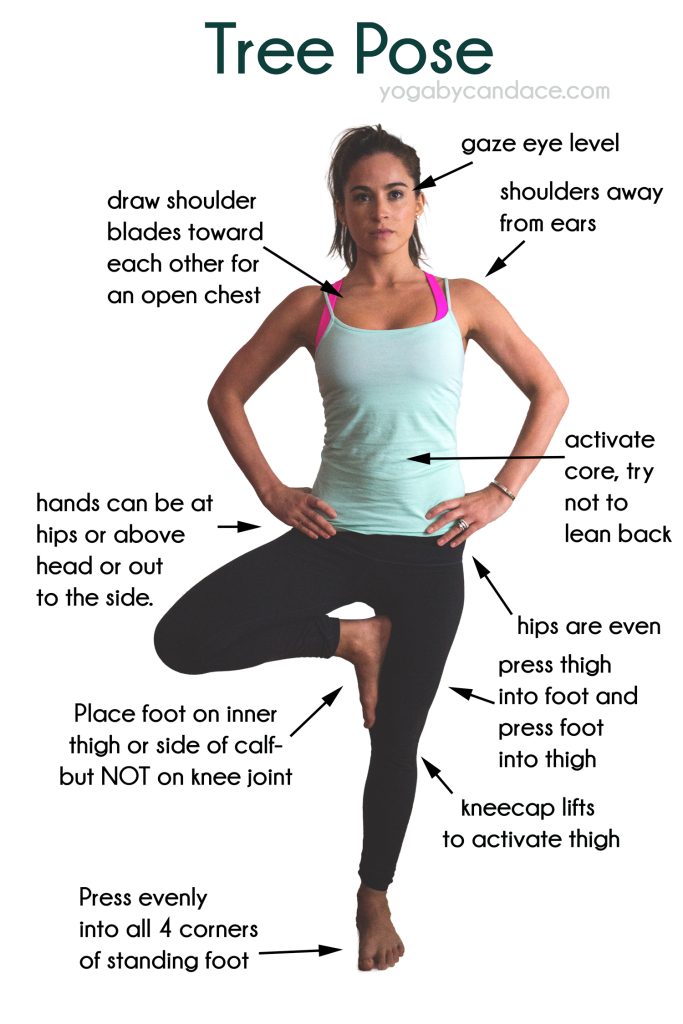
Tree Pose is all about balance and focus. It’s like standing on one leg and learning how to steady yourself. This pose is fun but needs a bit of concentration.
How to do it:
- Start in Mountain Pose: Begin with your feet together, just like we did in Mountain Pose.
- Lift One Foot: Slowly lift your right foot and place it on the inside of your left leg. Avoid putting it on your knee; aim for the lower part of your thigh or calf.
- Press Your Hands Together: Bring your palms together in front of your chest or raise them above your head if you feel stable.
- Keep Breathing: Take deep, slow breaths and try to hold your balance. If you wobble, it’s okay – just put your foot back down and try again on the other side.
Benefits:
- Improves Balance: Standing on one leg helps your body learn how to balance better.
- Strengthens Legs: Your leg muscles work hard to keep you steady, which makes them stronger over time.
- Increases Focus: Focusing on keeping still can help clear your mind and make you feel calm.
Tree Pose might feel a little tricky, but with practice, it becomes easier. It teaches you how to concentrate and trust your body. When you look at a tree, you notice how steady it is even in the wind. You can think of yourself as a little tree, rooting yourself in the ground. For more guidance on different yoga types, you can visit Discover the different types of yoga.
Extra Tips:
- Use a Wall: If you feel too wobbly, practice near a wall so you can gently touch it for support.
- Alternate Legs: Practice switching between your left and right legs. This makes both sides of your body stronger.
- Stay Relaxed: Try not to tense your face or shoulders. The goal is to keep the body relaxed but aware.
Tree Pose is a fun way to challenge yourself. It might feel hard at first, but over time you’ll see that your balance and focus improve a lot. It’s a reminder that a little practice can make a big difference!
3. Warrior Pose
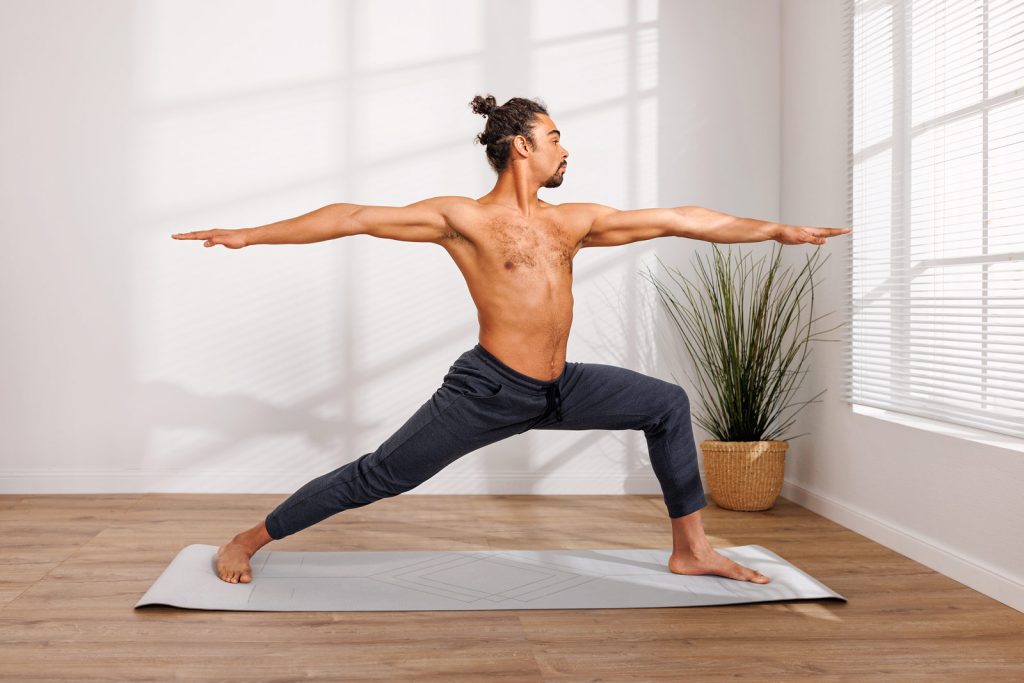
Warrior Pose is a strong pose that helps you build power and strength. It makes you feel brave, like you can take on anything. Even though it’s called Warrior, you don’t need to fight anything – it’s just about feeling strong and steady.
How to do it:
- Stand with Your Legs Apart: Start by standing with your feet wide. Make sure you have enough space around you.
- Turn One Foot Out: Turn your right foot out so that it faces the front. Your left foot should stay turned in a bit, making a nice angle.
- Bend Your Right Knee: Slowly bend your right knee so that it is directly above your ankle. Your thigh should be parallel to the floor if you can manage it without hurting your knee.
- Stretch Your Arms: Extend your arms. One arm goes forward and the other stretches back. Keep them parallel to the floor.
- Look Ahead: Keep your head straight and gaze forward. Breathe in deeply and slowly.
Benefits:
- Strengthens the Legs: Bending your knee and keeping your stance wide builds strength in your legs.
- Boosts Confidence: The power you feel in this pose can make you feel more confident and brave.
- Improves Focus: Concentrating on the position of your body helps to improve mental focus.
Warrior Pose is a bit more challenging than the first two poses, but it is very rewarding. It reminds you that strength isn’t just about muscle, but also about balance and focus. It’s a good idea to practice it on both sides, so you build equal strength in both legs. For more detailed guidance on yoga poses, check out our page on The 8-Fold Path of Yoga: A Comprehensive Guide.
Extra Tips:
- Watch Your Knee: Don’t let your knee go past your ankle when you bend. This helps keep your joints safe.
- Even Breathing: Remember to breathe slowly and evenly while holding the pose.
- Take Breaks: If you feel too tired, pause for a moment and try again. Every little bit of practice counts.
This pose builds up your inner strength. Even if it feels a bit tough, keep trying and you will notice improvements. It’s okay to take your time to get it right, and every attempt helps your body grow stronger.
4. Bridge Pose
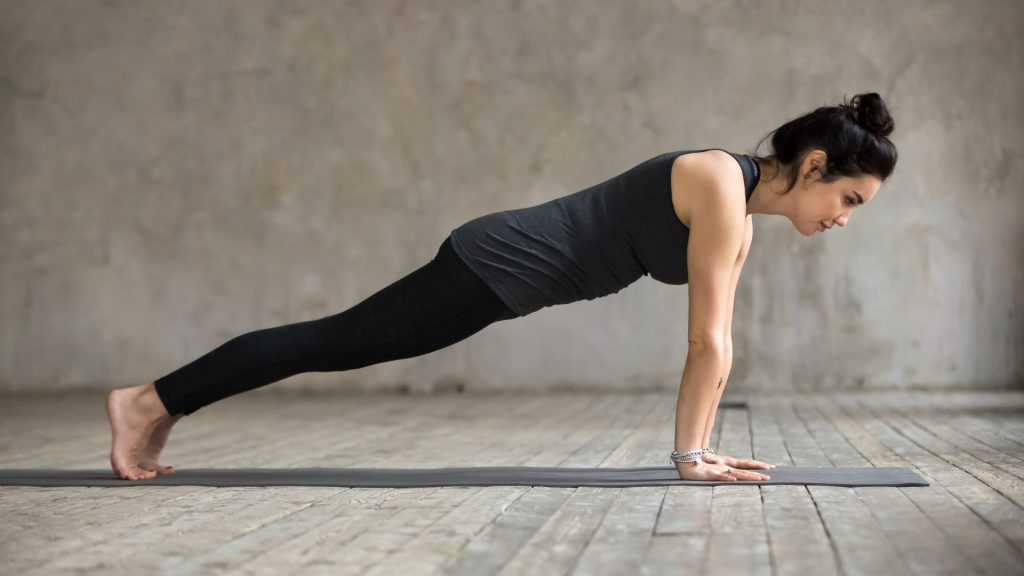
Bridge Pose is a gentle way to open up your chest and make your back stronger. It is a pose that helps you feel open and relaxed, while also working on your body strength.
How to do it:
- Lie on Your Back: Start by lying on a comfortable mat. Keep your back flat on the floor.
- Bend Your Knees: Place your feet flat on the ground, about hip-width apart. Your knees should be bent and pointing upward.
- Lift Your Hips Slowly: Using your legs and lower back, gently lift your hips off the ground. Keep your feet and shoulders in contact with the mat.
- Clasp Your Hands: If you can, interlace your fingers under your back. This helps to hold the pose better.
- Hold and Breathe: Stay in the pose for several deep breaths. When you are ready, slowly lower your hips back to the floor.
Benefits:
- Opens the Chest: By lifting your hips, you open up the chest and improve your breathing.
- Strengthens the Back: The muscles in your lower back work to support you in this pose, making them stronger over time.
- Reduces Tension: It’s a nice way to relieve stress in your back and neck after a long day.
Bridge Pose is simple but effective. It gives you a gentle stretch and strengthens key parts of your body. If you ever feel a bit sore in your back or chest, this pose can help ease that tension. For more on keeping your mind and body calm, check out Mindfulness vs Meditation: Discover Key Difference.
Extra Tips:
- Keep It Slow: Move slowly when lifting and lowering your hips. This helps prevent injury.
- Feel Your Breath: Use your breath to guide the movement. Inhale as you lift, and exhale as you lower.
- Don’t Overdo It: If you feel any sharp pain, stop immediately and rest. It’s better to take it easy and come back later.
Bridge Pose is a great way to make sure your back and chest stay strong and flexible. It might seem a bit unusual at first, but it’s a friendly pose that can help you feel more open and relaxed.
5. Child Pose

Child Pose is a cozy, resting pose that helps you take a break and let your body relax. It’s one of the most comforting poses and is great for when you need a little rest between more active movements.
How to do it:
- Start on Your Knees: Sit on your knees with your big toes touching. Spread your knees a bit apart for comfort.
- Lean Forward: Slowly lower your upper body towards the floor. Allow your chest to rest gently on your thighs.
- Rest Your Head: Let your head and forehead touch the ground. You can also use a soft pillow if it feels better.
- Stretch Your Arms: Extend your arms forward on the floor with your palms down. Alternatively, you can let your arms relax by your sides.
- Breathe Deeply: Close your eyes, and take slow, deep breaths, letting your body sink into the pose.
Benefits:
- Eases Tension: Child Pose is great for easing tension in your back and shoulders.
- Calms the Mind: The pose helps slow your breathing and clear your thoughts, making you feel peaceful.
- Encourages Rest: It gives you a chance to pause and recover during a busy yoga session.
Child Pose is like a little break for your body. Even if you’re not very flexible, this pose will let you feel comforted and safe. It’s a pose you can always come back to when you need a rest. For more gentle tips and ways to unwind, you might want to visit our page on 5 Meditation Techniques for You to Practice.
Extra Tips:
- Comfort First: If your knees hurt, you can put a soft blanket under them.
- Adjust Your Arms: Experiment with your arms’ position until you find a comfortable spot.
- Take Your Time: Stay in this pose as long as you need. There’s no rush, and every moment in Child Pose is a moment of rest.
Child Pose is a friendly way to relax. It helps you reconnect with your breath and clear your mind. Even if you feel a little clumsy at first, this pose is here to remind you that taking a break is okay.
6. Garland Pose
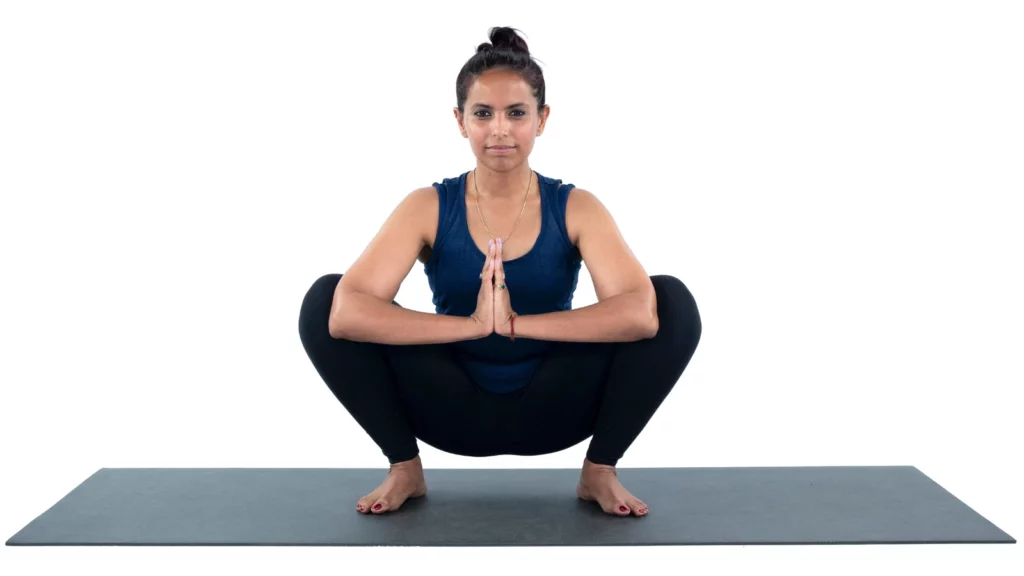
Garland Pose is a squat-like position that helps you improve your flexibility, especially in your hips and legs. It’s a simple pose that can make you feel more connected to your body.
How to do it:
- Stand with Your Feet Apart: Begin by standing with your feet a bit wider than your hips.
- Squat Down Slowly: Lower your body slowly into a squat. Keep your back as straight as possible.
- Bring Your Hands Together: Once you’re in a squat, bring your hands together in front of your chest in a prayer-like position.
- Breathe Steadily: Hold the position and take deep, steady breaths.
- Feel the Stretch: Notice the stretch in your hips and legs. Stay in the pose for as long as it feels good.
Benefits:
- Improves Hip Flexibility: This pose stretches the muscles around your hips, making them more flexible.
- Strengthens the Lower Body: Squatting helps build strength in your legs and lower back.
- Promotes Better Digestion: The gentle compression of the stomach can help with digestion, making you feel lighter after meals.
Garland Pose is simple but can be a bit challenging if you’re not used to squatting for long periods. It teaches you how to use your body weight wisely. For more ideas on staying connected with nature and your body, visit Benefits of Forest Bathing.
Extra Tips:
- Go Slow: Don’t rush into the squat. Lower yourself gradually to avoid any strain.
- Use Support if Needed: If you feel unstable, practice near a wall or hold onto something for balance.
- Keep Your Chest Up: Make sure your chest stays open and your back stays straight to get the full benefit.
Garland Pose might make you feel a bit low to the ground, but it is a powerful way to connect with your body. It teaches you about balance and the importance of gentle movement.
7. Plank Pose
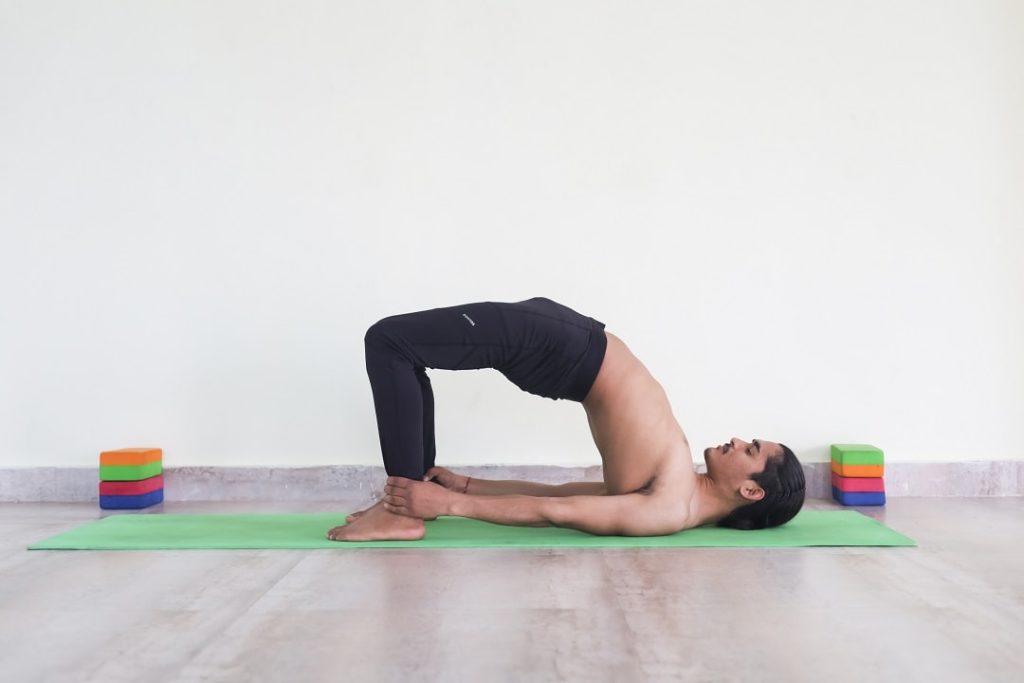
Plank Pose is a strong pose that makes your whole body work. It’s like holding a push-up position without moving, and it can really build up your core strength. This pose is not too hard, but it does need focus and control.
How to do it:
- Start on Your Hands and Knees: Begin by getting on the floor on all fours.
- Straighten Your Legs: Slowly extend your legs back until your body forms a straight line from your head to your heels.
- Keep Your Hands Under Your Shoulders: Make sure your hands are placed right below your shoulders, and your fingers are spread out.
- Hold the Position: Stay in this pose for a set time, even if it’s just a few seconds at first. Try to keep your body as straight as possible.
- Breathe Slowly: Maintain a steady breath while you hold the pose.
Benefits:
- Builds Core Strength: Plank Pose works on your abdominal muscles, back, and shoulders.
- Improves Endurance: Holding the position strengthens not just your body but also your focus and willpower.
- Enhances Stability: The longer you hold the pose, the better your balance and overall stability get.
Plank Pose is a bit challenging but it’s really rewarding. It helps you build a strong base, which is important for every other movement you do. For more information on how yoga can improve your mental and physical health, check out Meditation for Mental Health: Benefits & Techniques.
Extra Tips:
- Keep Your Hips Low: Avoid letting your hips go up too high or sag down too low.
- Focus on Your Form: It’s better to hold a perfect plank for a few seconds than a long, sloppy one.
- Practice Regularly: Even if you start with a few seconds, try to gradually increase the time as you get stronger.
Plank Pose might feel a bit like hard work, but every moment you spend in it makes your body stronger. It’s a reminder that a little effort every day can bring big changes.
8. Corpse Pose
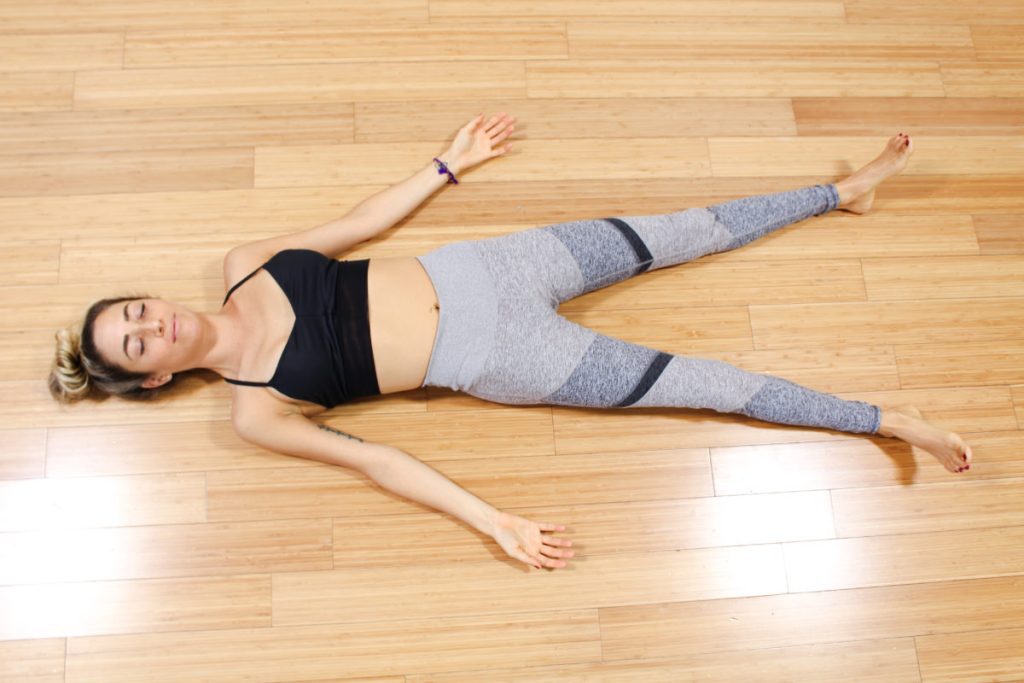
Corpse Pose is the final resting pose in a yoga session. It sounds a bit odd, but it is all about letting your body and mind relax completely. After all the work of the previous poses, this one is like a gentle goodbye to stress.
How to do it:
- Lie on Your Back: Find a comfortable spot on your yoga mat and lie down on your back.
- Spread Your Arms and Legs: Let your arms and legs fall naturally to the sides. There’s no need to hold any position; just let them rest.
- Close Your Eyes: Slowly close your eyes and focus on your breathing.
- Stay Still and Relax: Don’t try to change anything. Just let your body relax, and feel each breath as it comes and goes.
- Stay in the Pose: Remain here for a few minutes. This pose is meant to help you absorb all the benefits of your yoga practice.
Benefits:
- Deep Relaxation: Corpse Pose helps calm your mind and relax your body completely.
- Reduces Stress: It is a perfect way to end a yoga session, as it lowers your stress levels.
- Improves Mental Clarity: As you lie still, you give your mind a chance to clear out the clutter and relax.
Even though Corpse Pose might look simple, it is one of the most important poses in yoga. It teaches you that relaxation is just as important as strength and balance. For more background on relaxation and meditation, visit History and Origin of Meditation.
Extra Tips:
- Use a Blanket: If the floor feels too hard, place a soft blanket underneath you.
- Don’t Rush: Allow yourself plenty of time in this pose. It’s all about unwinding and letting go.
- Focus on Your Breath: Count your breaths or simply enjoy the quiet moment as you relax.
Corpse Pose is like a soft sigh after all the activity. It brings everything together and leaves you feeling calm and refreshed. Even if you feel a bit silly lying there, know that this simple rest is a powerful part of the yoga practice.
Final Thoughts on Safe Yoga Practice
Practicing yoga isn’t about being perfect—it’s about learning your body’s language and treating it with care. Every pose, from Mountain to Corpse, has a purpose and helps you grow stronger, calmer, and more balanced. Remember, it’s okay to take breaks, adjust your position, or try a pose again if it doesn’t feel right the first time.
Here are a few final tips to keep in mind as you practice:
- Listen to Your Body: If any pose hurts or feels too much, stop and rest. You can always try again later.
- Take It Slow: There’s no need to rush through your routine. Slow, steady movements help you do each pose correctly.
- Practice Regularly: Even if it’s just a few minutes every day, regular practice builds strength and flexibility over time.
- Mix and Match: Feel free to combine different poses in your routine. It’s okay to experiment with what feels best for you.
- Stay Consistent: Yoga is a journey. Every day you practice, you’ll notice small improvements in how you feel.
You can always revisit our detailed pages for more ideas and tips. For instance, if you want to know more about meditation and its benefits for mental health, check out Meditation for Mental Health: Benefits & Techniques. Or, if you’re curious about the roots of meditation, our article on History and Origin of Meditation is a great read.
Frequently Asked Questions (FAQ)
Q: What if I fall while doing Tree Pose?
A: It’s totally okay to lose balance sometimes. Use a wall or chair for support until you feel steadier. Everyone starts somewhere!
Q: How long should I hold each pose?
A: For beginners, 20 to 30 seconds per pose is a good start. As you grow stronger, you can hold them longer.
Q: Can I do these poses every day?
A: Yes, you can practice these poses daily. Listen to your body and rest when needed. Consistency is key, but so is care.
Q: What do I do if I feel pain in my knee during Warrior Pose?
A: Stop immediately and check your alignment. It might help to reduce the bend in your knee or to practice near a support until you’re comfortable.
Q: How can I improve my balance for poses like Tree Pose?
A: Regular practice, using supports like walls, and focusing on even breathing can help improve your balance over time.
Q: What’s the most important thing to remember when practicing yoga?
A: The most important thing is to be kind to yourself. Every body is different, and it’s okay to modify poses so that they work best for you.
Q: How do I know if I’m doing a pose correctly?
A: Pay attention to how your body feels. If you’re comfortable and breathing steadily, you’re on the right track. You can also watch videos or check our pages for visual cues.
Q: Should I practice yoga on an empty stomach?
A: It’s best to practice yoga when you’re not too full. A light snack is okay, but try to avoid heavy meals before you start.
Conclusion
Practicing yoga safely is all about simple steps, clear instructions, and listening to your body. With poses like Mountain, Tree, Warrior, Bridge, Child, Garland, Plank, and Corpse, you have a range of moves that build strength, balance, and calm. Follow the step-by-step guides, use the clickable images for extra help, and don’t be afraid to take your time. Every session, no matter how short, adds up to a healthier, happier you.
Remember, the goal is to enjoy the journey. Even if you make a few small mistakes or feel clumsy sometimes, that’s perfectly okay. Over time, you’ll see improvements and feel more confident in your practice. For more tips, tutorials, and detailed guides, be sure to explore our other pages like Discover the different types of yoga, The 8-Fold Path of Yoga: A Comprehensive Guide, and more.
Keep practicing, stay safe, and have fun with your yoga journey. Every breath, every pose, and every moment on your mat is a step toward feeling better inside and out. Enjoy the process, and let yoga help you grow stronger every day.




